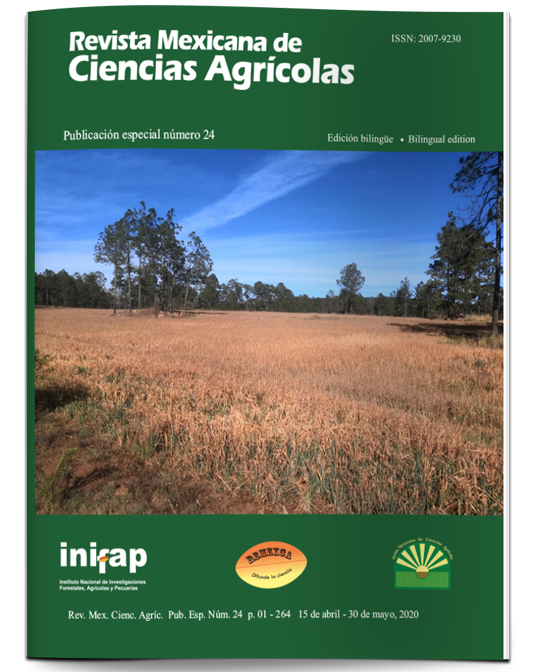Componentes estructurales del pasto Chetumal a diferentes manejos de pastoreo
DOI:
https://doi.org/10.29312/remexca.v0i24.2354Palabras clave:
acumulación del forraje, frecuencias, intensidades de pastoreoResumen
El objetivo fue estudiar el efecto de las diferentes frecuencias e intensidades de pastoreo en los componentes estructurales de una pradera de Brachiaria humidicola. Las frecuencias de cortes fueron a los 21 y 28 d y las intensidades de 9-11 y 13-15 cm de altura. Las variables se analizaron en un diseño de bloques al azar con arreglo factorial 2 x 2. Se determinó acumulación del forraje, dinámica de tallos y tasa de crecimiento foliar. En la época de lluvias se concentró 67 y 64% de la producción forrajera anual, al pastorear a 21 y 28 d, respectivamente. La densidad de tallos durante la época de lluvias fue 11% mayor en el primer ciclo, 11 y 20% en nortes de ambos ciclos al pastorear cada 21 día. La tasa de aparición de tallos en la época de lluvias disminuyó 21% al ampliar el intervalo entre pastoreo de 21 a 28 días, respectivamente. La mayor acumulación del forraje, recambio de tejido foliar y peso por tallo, se obtuvo al pastorear a una intensidad ligera de 13-15 cm de altura cada 28 días
Descargas
Descargas
Publicado
Cómo citar
Número
Sección
Licencia
Los autores(as) que publiquen en Revista Mexicana de Ciencias Agrícolas aceptan las siguientes condiciones:
De acuerdo con la legislación de derechos de autor, Revista Mexicana de Ciencias Agrícolas reconoce y respeta el derecho moral de los autores(as), así como la titularidad del derecho patrimonial, el cual será cedido a la revista para su difusión en acceso abierto.
Los autores(as) deben de pagar una cuota por recepción de artículos antes de pasar por dictamen editorial. En caso de que la colaboración sea aceptada, el autor debe de parar la traducción de su texto al inglés.
Todos los textos publicados por Revista Mexicana de Ciencias Agrícolas -sin excepción- se distribuyen amparados bajo la licencia Creative Commons 4.0 atribución-no comercial (CC BY-NC 4.0 internacional), que permite a terceros utilizar lo publicado siempre que mencionen la autoría del trabajo y a la primera publicación en esta revista.
Los autores/as pueden realizar otros acuerdos contractuales independientes y adicionales para la distribución no exclusiva de la versión del artículo publicado en Revista Mexicana de Ciencias Agrícolas (por ejemplo incluirlo en un repositorio institucional o darlo a conocer en otros medios en papel o electrónicos) siempre que indique clara y explícitamente que el trabajo se publicó por primera vez en Revista Mexicana de Ciencias Agrícolas.
Para todo lo anterior, los autores(as) deben remitir el formato de carta-cesión de la propiedad de los derechos de la primera publicación debidamente requisitado y firmado por los autores(as). Este formato debe ser remitido en archivo PDF al correo: revista_atm@yahoo.com.mx; revistaagricola@inifap.gob.mx.
Esta obra está bajo una licencia de Creative Commons Reconocimiento-No Comercial 4.0 Internacional.



